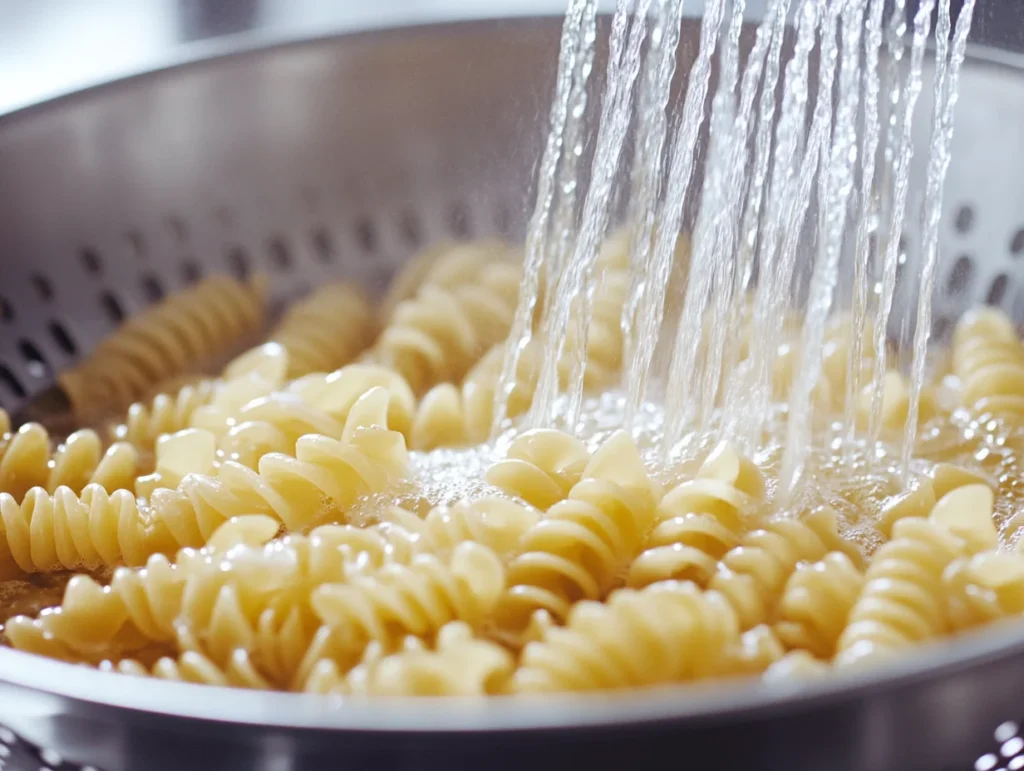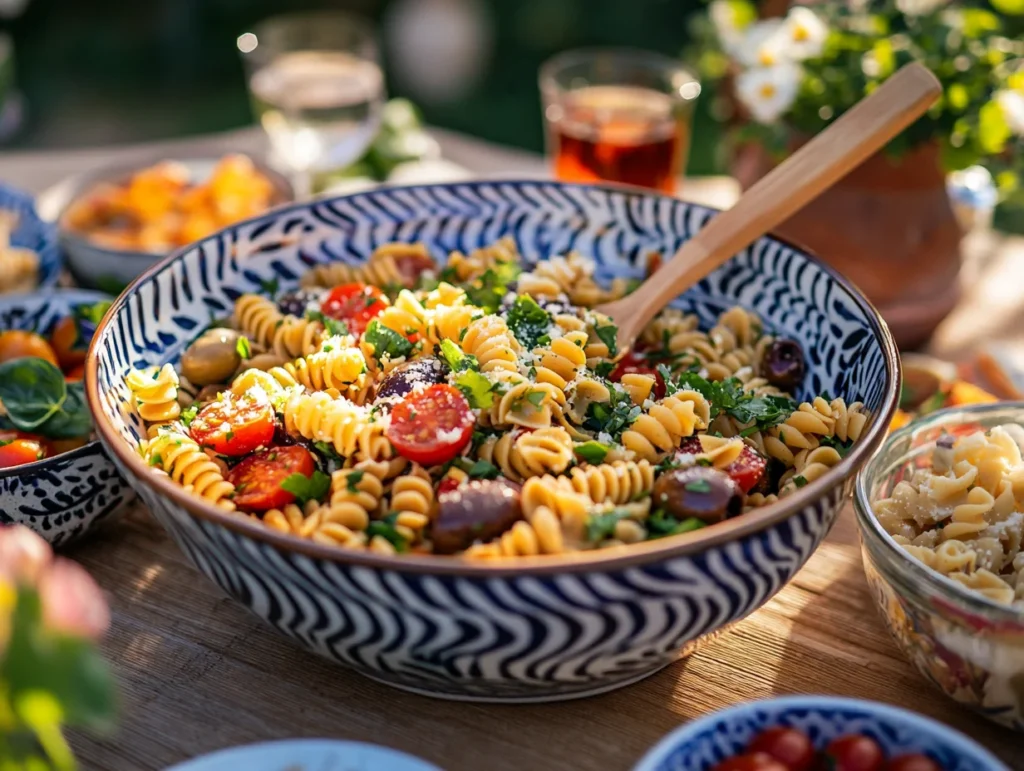Pasta salad is a crowd-pleaser that often graces tables at lunches, barbecues, and potlucks. It’s the perfect blend of textures and flavors, offering something for everyone. But let’s be honest—making a truly great pasta salad isn’t as easy as it looks. Whether it’s overly mushy noodles, bland dressing, or a lack of balance, a poorly made pasta salad can quickly turn into a forgettable side dish. So, how do you avoid these pitfalls? By understanding what are the five mistakes to avoid pasta salad and learning how to fix them, you can elevate your pasta salad game and wow your guests every single time.
Mistake #1: Choosing the Wrong Pasta Shape for Your Pasta Salad
The type of pasta you use in your salad plays a bigger role than you might think. Many people assume they can toss in whatever they have on hand, but not all pasta shapes are created equal. The wrong shape can result in uneven distribution of dressing and mix-ins, leaving some bites packed with flavor and others bland.
Choosing the right shape means opting for pasta that holds dressing well and complements the other ingredients, a critical step in understanding what are the five mistakes to avoid pasta salad. For example, small, sturdy shapes like rotini, cavatappi, and macaroni are ideal because their ridges and curves trap dressing and mix-ins. Rotini spirals are perfect for clinging to every drop of vinaigrette, while macaroni’s hollow structure soaks up creamy dressings beautifully. Avoid flat shapes like farfalle, which tend to cook unevenly and don’t hold dressing well, or long noodles like spaghetti, which are impractical for serving and eating in a salad.
When selecting your pasta, think about the balance of texture and flavor. For example, tortellini might seem appealing, but its bulky size can overpower other ingredients. By starting with the right base, you’re already setting your pasta salad up for success.
Mistake #2: How Overcooking or Undercooking Pasta Ruins Your Salad

One of the biggest challenges in making pasta salad is achieving the perfect texture. If you overcook the pasta, it turns mushy, soaks up too much dressing, and loses its shape. On the other hand, undercooked pasta feels unpleasantly chewy and doesn’t mix well with the rest of the ingredients.
To get the texture just right, always cook your pasta al dente—or even slightly under al dente—when making pasta salad. This ensures that the pasta retains its firmness even after absorbing dressing and sitting in the fridge. A good rule of thumb is to taste the pasta toward the end of the recommended cooking time. If it’s firm but not crunchy, it’s ready.
One common mistake is skipping the salt when boiling the water. Salting your pasta water is crucial because it’s your only opportunity to season the pasta itself. The water should taste as salty as the sea to ensure the pasta absorbs enough flavor. Another error to avoid is adding oil to the water. While it may prevent the pasta from sticking together, it also creates a slick surface that makes it difficult for the dressing to adhere.
Properly cooked pasta is the backbone of your salad, so take the time to get it right. Once the pasta is drained, it’s ready to move on to the next step.
Mistake #3: Why Skipping the Rinse Step Leads to Clumpy Pasta Salad
Rinsing pasta might sound like a no-no if you’ve been taught to skip it when cooking for hot dishes. However, when it comes to pasta salad, rinsing is essential. This simple step makes all the difference in texture and flavor absorption.
When pasta is cooked, it releases starch, which can make it clump together once cooled. By rinsing the pasta under cold water immediately after draining, you remove that excess starch and cool the pasta to the perfect temperature for dressing. Cold pasta holds its shape better and won’t wilt any fresh ingredients you add later, such as herbs or vegetables.
To rinse properly, place the pasta in a colander and run cold water over it, gently tossing the noodles to ensure even cooling. Once the pasta is completely cooled and no longer steaming, give it a gentle shake to remove excess water. Skipping this step might leave you with sticky, clumpy pasta that doesn’t mix well with dressing or other ingredients.
Rinsing also helps prevent overcooking. Since the pasta continues to cook for a short time after being removed from boiling water, cooling it down immediately locks in the right texture.
Mistake #4: Adding Dressing at the Wrong Time
Dressing your pasta salad is all about timing. Add it too early, and the pasta absorbs all the dressing, leaving the dish dry and bland. Add it too late, and the dressing won’t blend properly, creating an uneven mix of flavors.
For oil-based dressings, the key is to add them when the pasta is still slightly warm. Warm pasta absorbs oil-based dressings beautifully, infusing each noodle with flavor. This method creates a dish where every bite is seasoned perfectly. However, for creamy dressings like those made with mayonnaise, you should wait until the pasta has cooled completely. Adding creamy dressings to warm pasta can cause the dressing to melt or separate, resulting in an unappetizing, greasy mess.
The best way to ensure your pasta salad stays moist and flavorful is to use a two-stage dressing method. First, toss the pasta with half of the dressing shortly after rinsing and cooling it. This allows the pasta to absorb the flavors deeply. Then, just before serving, mix in the remaining dressing to refresh the flavors and add a glossy finish. This technique guarantees a well-balanced, flavorful salad that never feels dry or soggy.
Mistake #5: Ignoring Flavor and Texture Balance
A truly great pasta salad isn’t just about the pasta and dressing—it’s about creating harmony between flavors and textures. If you’re not careful, your salad can end up one-dimensional, with nothing to excite the palate.
Seasoning is where many people go wrong. Cold dishes like pasta salad require stronger flavors because chilling dulls the taste. Be generous with salt, pepper, and other spices, and don’t forget a splash of acid, like lemon juice or vinegar, to brighten the overall flavor. Fresh herbs like parsley, basil, or dill add brightness, but they should be added just before serving to prevent wilting.
Texture is equally important when understanding what are the five mistakes to avoid pasta salad. A well-balanced pasta salad includes a variety of textures to keep it interesting. Add crunchy elements like toasted nuts, sunflower seeds, or chopped celery for contrast. Soft, creamy ingredients like mozzarella pearls, crumbled feta, or grated Parmesan provide richness. Juicy components like halved cherry tomatoes, roasted peppers, or diced cucumbers add bursts of freshness. By combining these elements, you’ll create a pasta salad that’s satisfying and well-rounded.
When it comes to cheese, opt for soft or finely grated varieties. Large chunks of cheese don’t mix well and can dominate the dish. Finally, be careful not to overload your salad with too many mix-ins, as this can overwhelm the pasta and throw off the balance.
Best Practices for Making Perfect Pasta Salad
To make your pasta salad shine, consider the seasonality of your ingredients. Seasonal produce like summer zucchini, fresh corn, or ripe cherry tomatoes can elevate the dish. For inspiration, check out this Caesar Pasta Salad with Grilled Chicken, which combines vibrant vegetables with tangy dressing for a perfect summer meal.
Food safety is another important factor. Pasta salad is often served at outdoor events, so it’s crucial to keep it fresh and safe. Follow Food Safety Guidelines for Cold Dishes to avoid spoilage. Refrigerate the salad within two hours of preparation, or within one hour if it’s hot outside. Store leftovers in an airtight container and consume them within three to five days. For extra freshness, stir in a little dressing before serving leftovers.
Conclusion
Avoiding these five mistakes can transform your pasta salad into a dish that’s not just good but truly exceptional. By learning what are the five mistakes to avoid pasta salad, such as choosing the right pasta shape, cooking it properly, rinsing it to the perfect temperature, dressing it at the right time, and balancing flavors and textures, you’ll be able to create a pasta salad that leaves everyone asking for seconds. So the next time you’re planning a lunch or picnic, put these tips into action and watch your pasta salad become the highlight of the table.

FAQs
1. What’s the best dressing for pasta salad?
Oil-based dressings like vinaigrettes are perfect for lighter salads, while creamy dressings such as ranch or mayonnaise add richness.
2. How long does pasta salad last?
Pasta salad can last up to 3-5 days in the refrigerator if stored in an airtight container. Avoid leaving it out for more than two hours to maintain freshness.
3. Can I freeze pasta salad?
While freezing pasta salad is possible, it’s not ideal. Freezing can alter the texture of the pasta and cause creamy dressings to separate.
4. Should I serve pasta salad warm or cold?
Pasta salad is best served cold or at room temperature, allowing the flavors to meld perfectly.
5. What’s the best way to pack pasta salad for a picnic?
Use a sealed, airtight container and keep it chilled with ice packs or a cooler to ensure it stays fresh and safe to eat.

